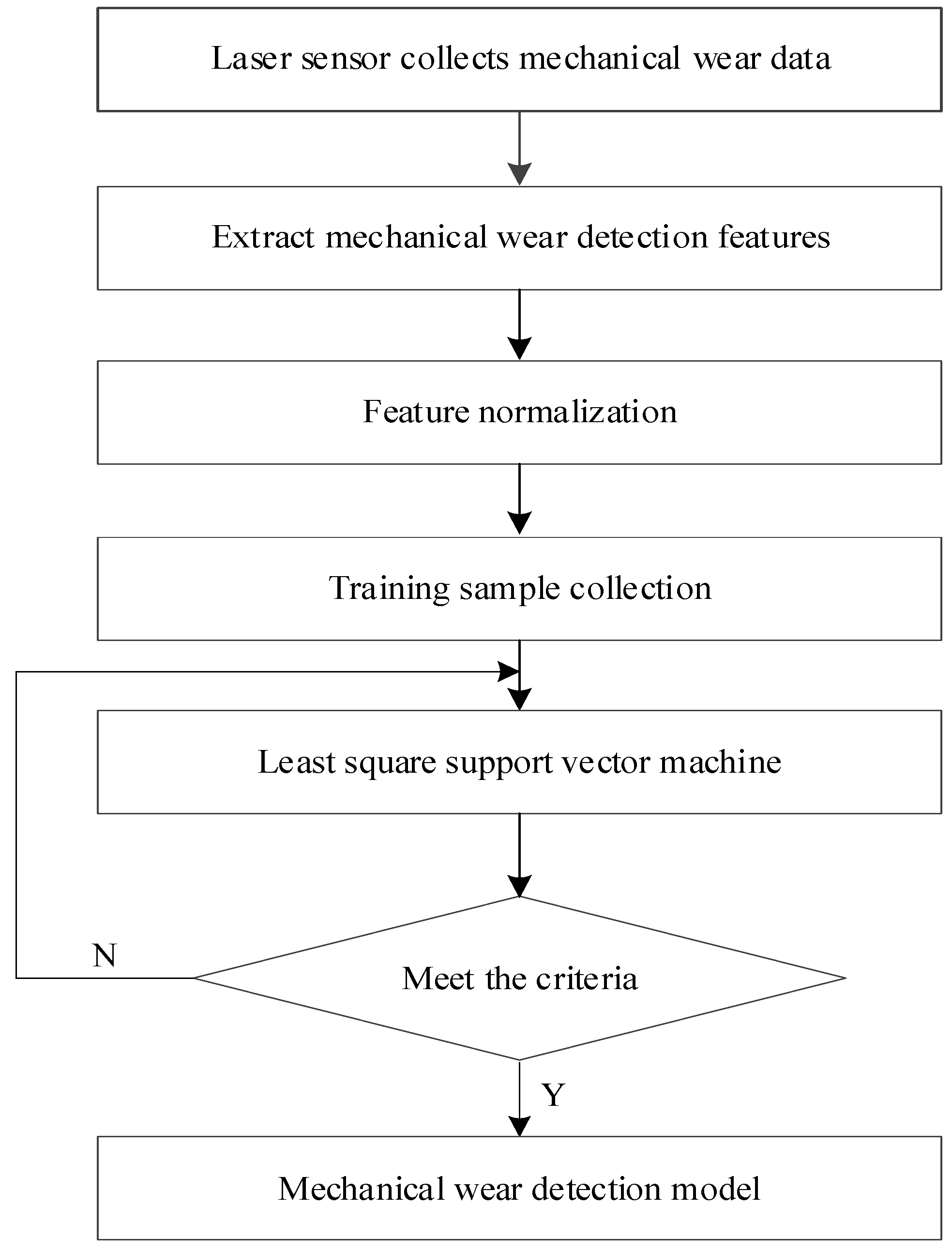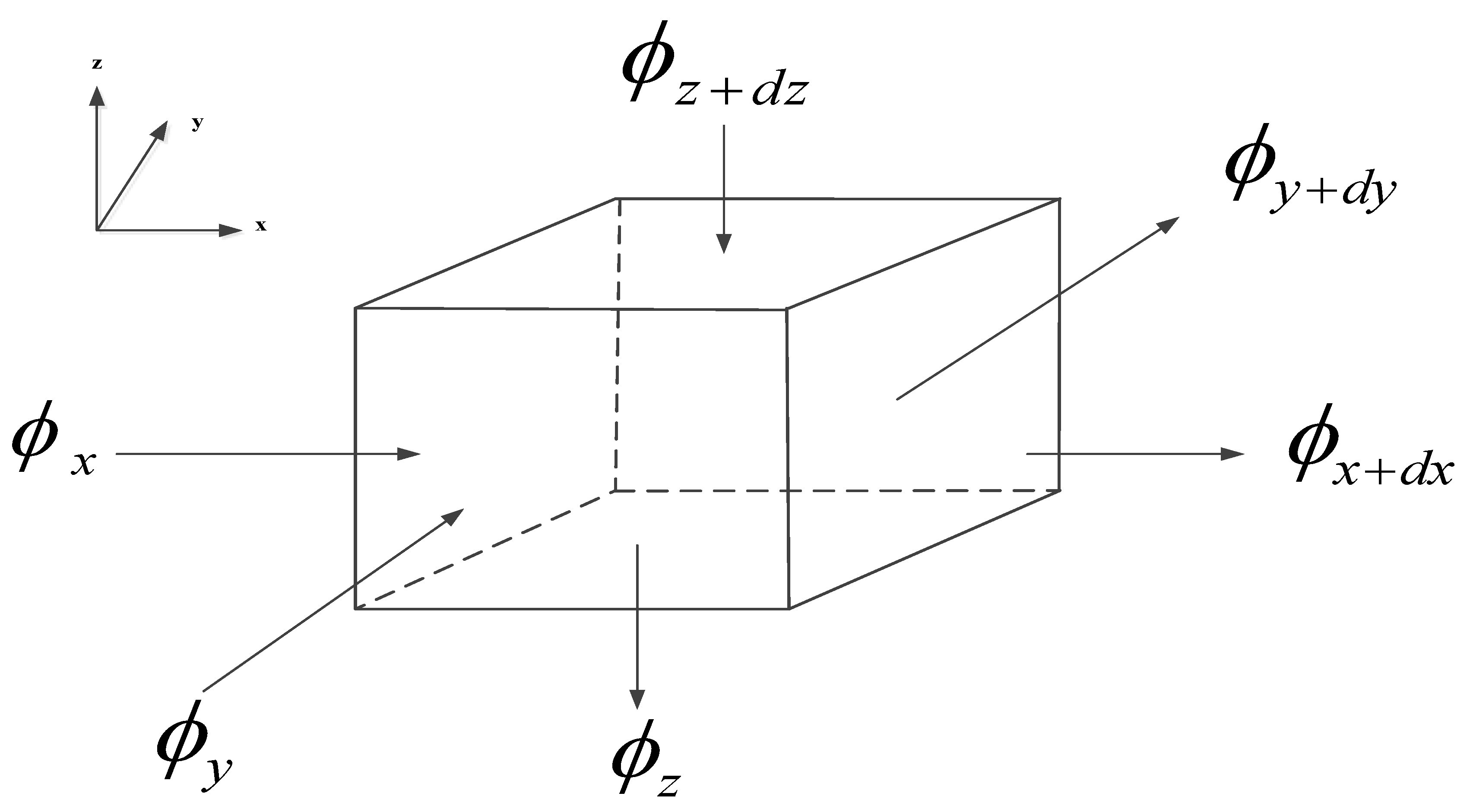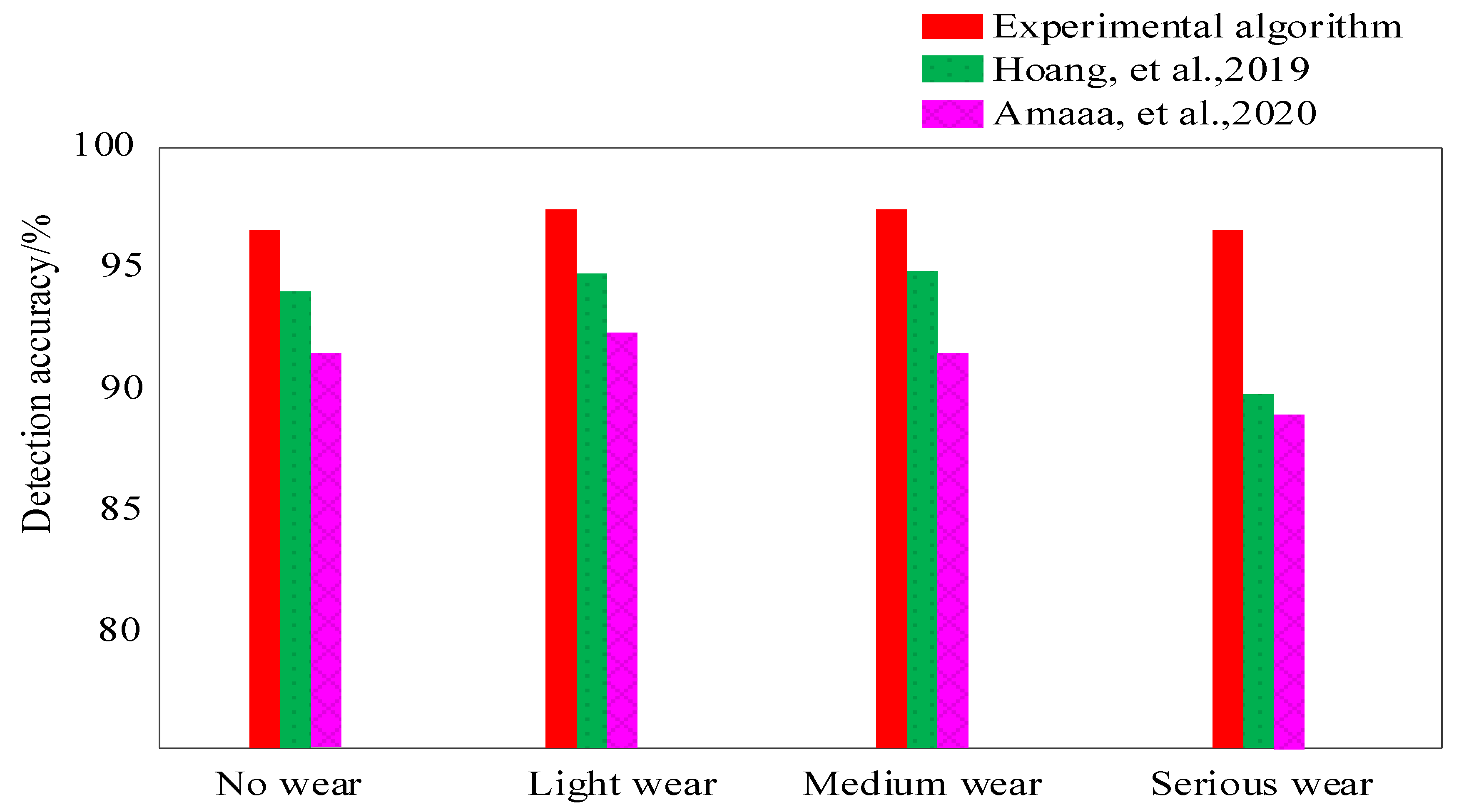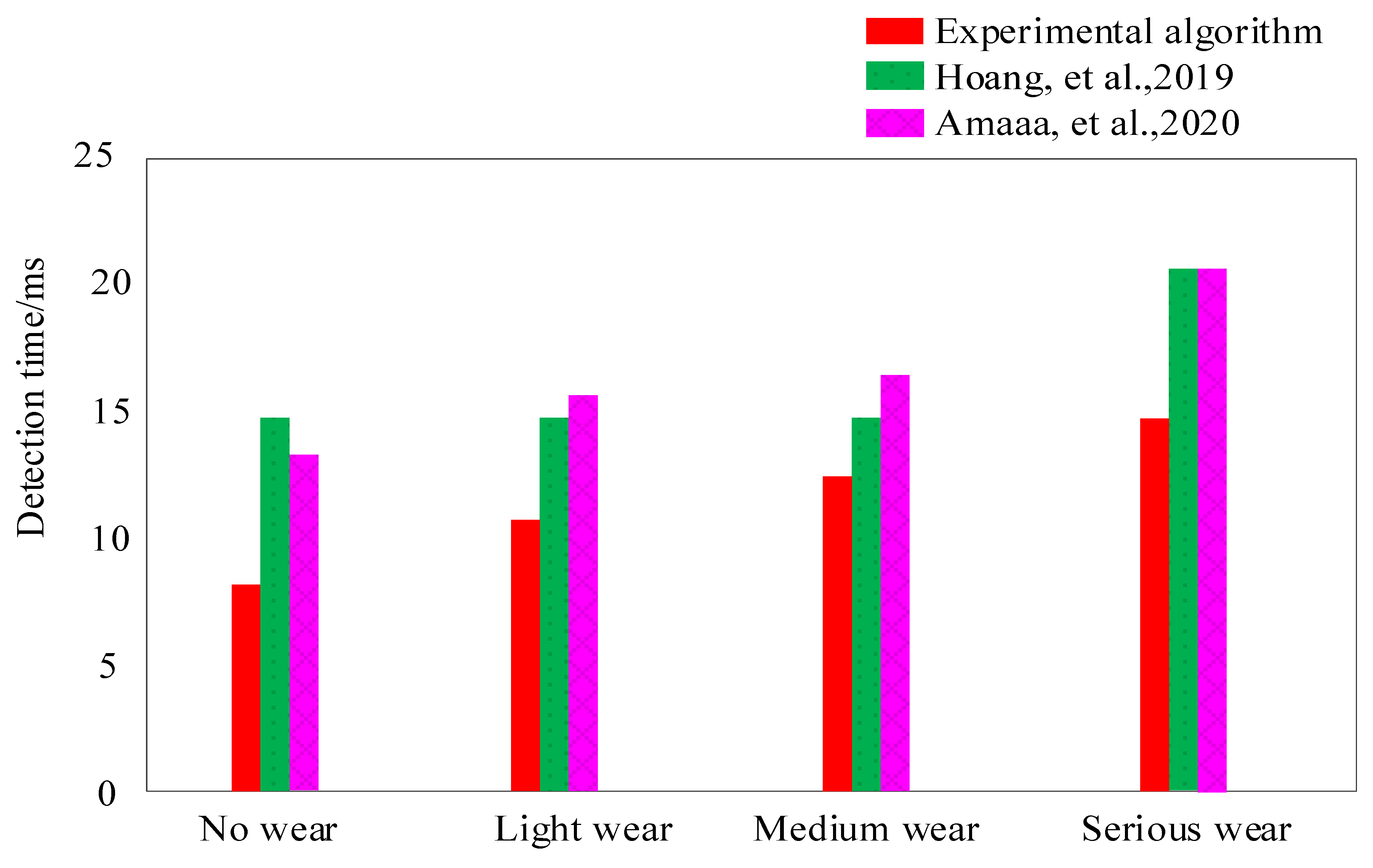Simulation Study on Mechanical Wear Detection of High-Power Diesel Engine Based on Thermodynamic Coupling
Abstract
:1. Introduction
2. Diesel Engine Mechanical Wear Detection Principle and Thermodynamic Parameters Monitoring
2.1. Principle of Mechanical Wear Detection
2.2. Brief Introduction of Thermal Parameter Monitoring Method
2.2.1. Thermal Analysis Theory
2.2.2. Mathematical Description of Heat Conduction Problem
2.2.3. Definite Solution Conditions
- (1)
- The first kind of boundary condition: for steady-state problems, the temperature value on the boundary is given, which is a function of spatial coordinates:For unsteady problems, the temperature value is also a function of time:
- (2)
- The second kind of boundary condition: the heat flux density on the boundary is given:In Equation (9), n is the normal direction of surface a.
- (3)
- The third kind of boundary condition: the temperature of the fluid outside the boundary and the convective heat transfer coefficient between the boundary and the external fluid are specified:In Equation (10), tw and are unknowns; for unsteady heat conduction, h and tf are time functions.
2.2.4. Elastic Mechanics Analysis Theory
- (1)
- Basic variables.
- (2)
- Basic governing equations. Under the external action, the elastic deformation will produce displacement, stress, and strain, which meet the corresponding control equations. The distribution is called the geometric equation of deformation, the physical equation of material, and the balance equation of force. The relationship between the strain component and displacement component is as follows:
- (3)
- The condition of definite solution. It includes the displacement boundary condition and force boundary condition. Expressions of displacement boundary conditions:
2.2.5. Thermoelastic Analysis Theory
3. Simulation of Diesel Engine Mechanical Wear Detection Based on Thermodynamic Coupling
3.1. Mechanical Wear Detection Algorithm
3.2. Coupled Thermodynamic Modeling
4. Case Analysis of Mechanical Wear Detection
4.1. Test Platform and Mechanical Wear Data
4.2. Results and Analysis
5. Conclusions
Author Contributions
Funding
Institutional Review Board Statement
Informed Consent Statement
Data Availability Statement
Conflicts of Interest
References
- Temizer, L.; Eskici, B. Investigation on the combustion characteristics and lubrication of biodiesel and diesel fuel used in a diesel engine. Fuel 2020, 278, 118363. [Google Scholar] [CrossRef]
- Zehni, A.; Saray, R.K.; Neshat, E. A detailed study of the effects of biodiesel addition and exhaust gas recirculation on diesel engine pcci combustion, performance and emission characteristics by kiva-chemkin coupling. J. Eng. Gas Turbines Power 2018, 140, 062801. [Google Scholar] [CrossRef]
- Yang, C.; Liu, R.; Jiao, Y.; Zhang, Z.; Zhou, G.; Ding, H.; Lu, C. Study on thermodynamic matching optimization of variable flow cooling system of diesel engine at high altitudes. Energy Sources Part A Recovery Util. Environ. Eff. 2020, 3, 1–19. [Google Scholar] [CrossRef]
- Kumar, K.M.; Munjal, M.L. Direct estimation and experimental validation of the acoustic source characteristics of two-cylinder naturally aspirated diesel engine exhaust system. Appl. Acoust. 2018, 135, 70–84. [Google Scholar] [CrossRef]
- Hoang, A.T.; Pham, V.V. A study of emission characteristic, deposits, and lubrication oil degradation of a diesel engine running on preheated vegetable oil and diesel oil. Energy Sources Part A Recovery Util. Environ. Eff. 2019, 41, 611–625. [Google Scholar] [CrossRef]
- Attia, A.M.; Nour, M.; El-Seesy, A.I.; Nada, S.A. The effect of castor oil methyl ester blending ratio on the environmental and the combustion characteristics of diesel engine under standard testing conditions. Sustain. Energy Technol. Assess. 2020, 42, 100843. [Google Scholar] [CrossRef]
- Hoang, A.T.; Le, V.V.; Pham, V.V.; Tham, B.C. An investigation of deposit formation in the injector, spray characteristics, and performance of a diesel engine fueled with preheated vegetable oil and diesel fuel. Energy Sources Part A Recovery Util. Environ. Eff. 2019, 41, 2882–2894. [Google Scholar] [CrossRef]
- Bagi, S.; Kamp, C.J.; Sharma, V.; Aswath, P.B. Multiscale characterization of exhaust and crankcase soot extracted from heavy-duty diesel engine and implications for DPF ash. Fuel 2020, 282, 118878. [Google Scholar] [CrossRef]
- Chen, Z.; Li, J.; Liao, J.; Shi, F. Stress and fatigue analysis of engine pistons using thermo-mechanical model. J. Mech. Sci. Technol. 2019, 33, 4199–4207. [Google Scholar] [CrossRef]
- Liu, J.; Dumitrescu, C.E. Improved thermodynamic model for lean natural gas spark ignition in a diesel engine using a triple wiebe function. J. Energy Resour. Technol. 2020, 142, 062303. [Google Scholar] [CrossRef]
- Pan, M.; Qian, W.; Huang, R.; Tong, C.; Huang, H.; Xu, L.; Hao, B. Effects of dimethyl carbonate and 2-ethylhexyl nitrate on energy distribution, combustion and emissions in a diesel engine under different load conditions. Energy Convers. Manag. 2019, 199, 111985. [Google Scholar] [CrossRef]
- Zhang, Y.; Zhan, L.; He, Z.; Jia, M.; Leng, X.; Zhong, W.; Qian, Y.; Lu, X. An investigation on gasoline compression ignition (GCI) combustion in a heavy-duty diesel engine using gasoline/hydrogenated catalytic biodiesel blends. Appl. Therm. Eng. 2019, 160, 113952. [Google Scholar] [CrossRef]
- Jannatkhah, J.; Najafi, B.; Ghaebi, H. Thermodynamic analysis of a four-stroke compression ignition engine fueled by corn biodiesel blends and pure diesel. Energy Sources Part A Recovery Util. Environ. Eff. 2019, 1–20. [Google Scholar] [CrossRef]
- Loganathan, S.; Martin, M.L.J.; Nagalingam, B.; Prabhu, L. Heat release rate and performance simulation of dme fuelled diesel engine using oxygenate correction factor and load correction factor in double wiebe function. Energy 2018, 150, 77–91. [Google Scholar] [CrossRef]
- Ding, N. Vibration analysis of offshore oil and gas platform mechanical equipment. J. Coast. Res. 2020, 106, 633–637. [Google Scholar] [CrossRef]
- Heda, Z. Fault diagnosis and life prediction of mechanical equipment based on artificial intelligence. J. Intell. Fuzzy Syst. 2019, 37, 3535–3544. [Google Scholar] [CrossRef]
- Li, X.; Feng, Y.; Liu, B.; Yi, D.; Yang, X.; Zhang, W.; Chen, G.; Liu, Y.; Bai, P. Influence of NbC particles on microstructure and mechanical properties of AlCoCrFeNi high-entropy alloy coatings prepared by laser cladding. J. Alloy. Compd. 2019, 788, 485–494. [Google Scholar] [CrossRef]
- Huo, J.; Lin, D.; Qi, W. Intelligent fault diagnosis method of mechanical equipment based on fuzzy pattern recognition. J. Intell. Fuzzy Syst. 2020, 38, 3657–3664. [Google Scholar] [CrossRef]
- Wang, L.; Chen, A.H.; Huang, Y.N. Simulation of NOX emission intensity control of diesel engine based on miller cycle. Comput. Simul. 2020, 37, 105–108. [Google Scholar]
- Qian, Z.; Huang, H. Coupling fatigue cohesive zone and magnetomechanical model for crack detection in coating interface. NDT E Int. 2019, 105, 25–34. [Google Scholar] [CrossRef]
- Zhao, G.X.; Wu, S.L.; Chen, H.C.; Zhao, W.J. Simulation research on fouling diagnosis of conducting heat tube in heat. Exch. Computer Simul. 2019, 36, 427–431. [Google Scholar]
- Jiao, Y.; Zheng, Q. Urea injection and uniformity of ammonia distribution in SCR system of diesel engine. Appl. Math. Nonlinear Sci. 2020, 5, 129–142. [Google Scholar] [CrossRef]
- Li, B.; Yang, H. Design of active vibration reduction system for intelligent ship mechanical equipment. J. Coast. Res. 2020, 115, 235–237. [Google Scholar] [CrossRef]
- Qin, C.; Jin, Y.; Tao, J.; Xiao, D.; Yu, H.; Liu, C.; Shi, G.; Lei, J.; Liu, C. DTCNNMI: A deep twin convolutional neural networks with multi-domain inputs for strongly noisy diesel engine misfire detection. J. Int. Meas. Confed. 2021, 180, 109548. [Google Scholar] [CrossRef]
- Zheng, J.; Zhang, C.; Li, A. Experimental investigation on the mechanical properties of curved metallic plate dampers. Appl. Sci. 2019, 10, 269. [Google Scholar] [CrossRef] [Green Version]
- Pham, V.V. Research on the application of diesel-RK in the calculation and evaluation of technical and economic criteria of marine diesel engines using the unified ULSD and biodiesel blended fuel. J. Mech. Eng. Res. Dev. 2019, 42, 87–97. [Google Scholar] [CrossRef]
- Wang, Y.; Zhang, G.; Shi, Z.; Wang, Q.; Su, J.; Qiao, H. Finite-time active disturbance rejection control for marine diesel engine. Appl. Math. Nonlinear 2020, 5, 35–46. [Google Scholar] [CrossRef]






| Numbering | Degree Of Mechanical Wear | Number Of Samples |
|---|---|---|
| 1 | No wear | 50 |
| 2 | Mild wear | 50 |
| 3 | Medium wear | 30 |
| 4 | Severe wear | 10 |
Publisher’s Note: MDPI stays neutral with regard to jurisdictional claims in published maps and institutional affiliations. |
© 2022 by the authors. Licensee MDPI, Basel, Switzerland. This article is an open access article distributed under the terms and conditions of the Creative Commons Attribution (CC BY) license (https://creativecommons.org/licenses/by/4.0/).
Share and Cite
Li, J.; Ma, B.; Liang, J.; Zhang, Y. Simulation Study on Mechanical Wear Detection of High-Power Diesel Engine Based on Thermodynamic Coupling. Processes 2022, 10, 1175. https://doi.org/10.3390/pr10061175
Li J, Ma B, Liang J, Zhang Y. Simulation Study on Mechanical Wear Detection of High-Power Diesel Engine Based on Thermodynamic Coupling. Processes. 2022; 10(6):1175. https://doi.org/10.3390/pr10061175
Chicago/Turabian StyleLi, Jingli, Baoqiu Ma, Jianwei Liang, and Yu Zhang. 2022. "Simulation Study on Mechanical Wear Detection of High-Power Diesel Engine Based on Thermodynamic Coupling" Processes 10, no. 6: 1175. https://doi.org/10.3390/pr10061175





